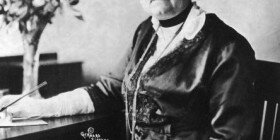Heroines of History – Jean Bartik: Human Computer
{}
Heroines of History: These are American women, and their actions were not motivated by fortune or fame. There was no glory, and in many cases very little recognition for their activities. They simply did what needed to be done, and they did so in an extraordinary way. They roared without making a sound and it is time that they were given a voice.
Jean Jennings Bartik we hear you.
Born the sixth of seven children to a family of teachers and farmers, Jean Bartik knew one thing with certainty; she did not want to be a teacher. So when she graduated, as the only mathematics major in her class, from Northwest Missouri State Teachers College, in 1945, she applied for work at IBM and at the Moore School at the University of Pennsylvania to be a computer. Before the advent of computers as we know them today, computer was the name given to an individual who did mathematical computations for a living. They would compute, and therefore, were called computers. Jean received a rejection notice from IBM, but an urgent telegram from the Moore School asking her to come right away.
Arriving in Philadelphia in March of 1945, Jean went directly to work with around 80 other girls calculating the trajectories of guns for firing tables. She excelled at this work. In June, an announcement was made that they were looking for five women to be the operators of the ENIAC project. Jean applied despite not knowing anything about the project other than it had been started in 1943 and was led by John Mauchly and J Presper Eckert. She was one of the five chosen and spent several months at the Aberdeen Proving Ground in training. The ENIAC, Electronic Numerical Integrator and Computer, was one of the first computers ever built, but it was not an all-purpose machine. The sole intent of the ENIAC was to calculate trajectories of guns. Cards would be placed into the machine, wires and switches would be manually manipulated to set the program and the resultant trajectories would be punched on the cards.
Originally, the five girls were to be trained on how to operate the machine only. The men needing the resultant information would be relied on to provide the program for the machine themselves. However, the programming required to operate the machine proved to be so complicated that it became evident that the girls would need to be relied upon for more than just the operation. A passing knowledge of the ENIAC would not be sufficient. With Jean and Frances Holberton at the lead the girls laid the groundwork for future programmers by creating the process of using subroutines and nested subroutines to expedite the process. In February of 1946, the ENIAC was demonstrated for the press. Throughout the demonstration the five girls operated the machine using their programs and the ENIAC produced the promised firing trajectories to the excitement of all present. However, at no point during the event, were the women ever introduced. In fact, years later in photographs from that day, the girls were identified as models.
Contrary to the lack of public recognition for Jean’s work, she was highly regarded by her colleagues. With WWII over, the focus on the ENIAC machine turned to converting it into a stored program machine. Dick Clippinger from Aberdeen and John von Neumann from Princeton set up a group and named Jean to lead the development. Not only did she successfully complete the development, but she also commonly visited Aberdeen to teach Clippinger how to program the ENIAC. By this time, Eckert and Mauchly had left the Moore School to start their own company. They received a commission from Northrup Aircraft Company to build the Binary Automatic Computer, or BINAC, which would store data on magnetic tape instead of cards. Jean helped design this computer, as well as working on the logical design for the UNIVAC I.
In 1950, Remington Rand Corporation took over Eckert-Mauchly Computer Corporation and renamed the organization the UNIVAC Division of Remington Rand. Having met and married an engineer, named William Bartik, while working at the Moore School, Jean followed him to Washington where he had found work. Jean continued to work for Remington Rand, but this time in the sales office training the Census Bureau programmers and the salesmen. She also worked on UNIVAC programs customized for the Aviation Supply Office for the Navy. However, when the Bartiks moved to Philadelphia and William took a job with Remington Rand, Jean was informed that she was not allowed to work for the same company as her husband. Frustrated, Jean left the computing world and took time off to have a family.
In addition to having three kids, Jean went back to school and received a master’s degree in English from the University of Pennsylvania in 1967. Unfortunately, the Bartik’s marriage was not a happy one and the two divorced in 1968. Jean went back to work for the Auerbach corporation publishing, combining her computer background with her new English degree as an editor for technical manuals. The minicomputer had been recently introduced so she focused her attention on that. She stayed at Auerbach for eight years and then skipped around to Interdata, Systems Engineering Labs in Florida and Honeywell working in product support and management of their minicomputer divisions. In 1980, Jean returned to publishing with Data Decisions where she stayed until they closed in 1986.
Unable to gain further employment in the technology field, Jean went into real estate where she worked for the rest of her life. An ardent advocate for an increase in women’s participation in science and technology, Jean was finally recognized for her work in 1998 when she was inducted into the ‘Women in Technology International Hall of Fame.’ Ten years later in 2008 she received a ‘Museum Fellows Award’ from the Computing History Museum and a computer Pioneer Award from the Institute of Electrical and Electronics Engineers Computer Society Board of Governors. She was also honored with the Joan S. Korenman Award in 2009 for her efforts as one of the first computer programmers. Jean Bartik passed away in 2011 at the age of 87.
Jean Jennings Bartik this is in your honor. Thank you for all that you did.






Never known or heard of someone like this! Such fascinating stories each and everyone of us carry within us! :) great job Kat! Look forward to more interesting articles from you!